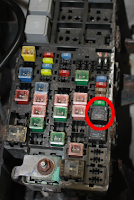 |
| Probably the original |
As the filter does its job, what it catches will reduce the flow rate through the filter, meaning the pump will need to work harder to provide the same amount of fuel as a clean filter, or the car will have figure out how to run with less gas that expected; in practice, both are probably happening.
Location and Removal
The filter is in front of the passenger side's rear wheel, it's easy to spot. I had the car lifted while working on something else; accessing the filter could be done with all four wheels on the ground if you don't fee like lifting anything. The extra few inches made things easier. If you have the front tires up ramps for an oil change, you'll have great access to the filter.
Here's what you'll need to to the job:
Here's what you'll need to to the job:
- 9mm socket or flathead screwdriver
- Quick release tool
- Basin to catch any fuel in the system
- Motorcraft FG986B filter (got mine from Amazon)
 |
| Fuel relay location |
 |
| Fresh from HF |
Quick Release
Next, before loosening the clamp, I used a quick release tool (a few bucks from
Harbor Freight) to free the lines from the filter. The basin caught a few tablespoons of fuel, about what I expected given the cars non-running status the past few weeks. The quick release tool fits around the hard part of the line and is then pushed against the connector, wedging underneath to unclip the connector. While not fancy, the tool for this purpose worked flawlessly.
Harbor Freight) to free the lines from the filter. The basin caught a few tablespoons of fuel, about what I expected given the cars non-running status the past few weeks. The quick release tool fits around the hard part of the line and is then pushed against the connector, wedging underneath to unclip the connector. While not fancy, the tool for this purpose worked flawlessly.
 |
| Push towards fitting |
Installation
How dirty was it?
Looking at the outside of the canister doesn't tell one much about the state of the filter, the interesting part's on the inside. Let's dissect the old filter like a middle-school frog and see what it trapped over the years. I was tempted to use my handy Dremel, but figured sparks and gasoline fumes would result in some unwanted outcomes. So I made an initial cut with a hack saw and used metal shears for the rest, working my way slowly around the can.I have a picture of the filter, showing the feed side next to the filtrate side, where the feed side is on the bottom and the browner, dirtier filter side is on the top. For those asleep during chemistry: there's three things in a filter system:
- Feed, what goes through the filter. In this case the gas from the tank
- Filtrate, what remains after passing through the filter. In our example, cleaner fuel
- Residue, what the filter catches and what we can see in our illustration. Looks like the filter paper itself has a red tint and the feed side looks covered in a greyish haze compared to the more vivid filtrate side.
 |
| Just a few taps... |



No comments:
Post a Comment